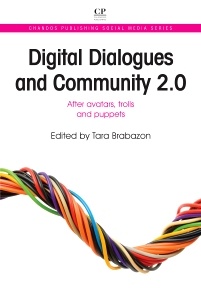Description
Digital Dialogues and Community 2.0
After Avatars, Trolls and Puppets
Chandos Publishing Social Media Series
Language: English
Subject for Digital Dialogues and Community 2.0:
320 p. · 15.5x23.2 cm · Paperback
Description
/li>Contents
/li>Biography
/li>Comment
/li>
List of tables and boxes
List of abbreviations
About the contributors
Introduction: new imaginings
Part 1: Communities, Exiles and Resistance
Chapter 1: The inevitable exile: a missing link in online community discourse
Abstract:
Place is the thing
Panoptical temptation
Reincarnation as networked norm
Forgiveness not permission
Culture jammer or parasite?
I’ve got you under my skin
Permaban and punish
Legibility and responsibility
Every tool is a weapon if you hold it right94
Chapter 2: Call it hyper activism: politicising the online Arab public sphere and the quest for authenticity and relevance
Abstract:
From blogging to YouTube: politicising the internet
From call-in programs to online comments: participatory culture
Chapter 3: What’s in a name? Digital resources and resistance at the global periphery
Abstract:
Resistance and the nation state
SouthAfrica.com
NewZealand.com
Tuvalu and .tv
.md: who represents Moldova?
What’s in a domain (name)?
Cautions and conflicts: .tp and Timorese independence
Chapter 4: I have seen the future, and it rings
Abstract:
Mobile phones and social change
Day-to-day use of mobile phones
Conclusion
Part 2: Structures for Sharing
Chapter 5: Strangers in the swarm
Abstract:
The history of file sharing
Bit Torrent
Identities in the swarm
The future
Chapter 6: Status (update) anxiety: social networking, Facebook and community
Abstract:
It’s all about me
Watching the self (being watched)
Chapter 7: Becoming Mireila: a virtual ethnography through the eyes of an avatar
Abstract:
Entry
Stripping Mireila
Feeders
Self
Chapter 8: Taste is the enemy of creativity: disability, YouTube and a new language
Abstract:
Disability is a social construction
Lessons from Picasso
Digital disability
Part 3: Professions, Production, Consumptions
Chapter 9: The sound of a librarian: the politics and potential of podcasting in difficult times
Abstract:
iPod studies
Why should librarians use podcasts?
Questions of quality
Chapter 10: The invisible (wo)man
Abstract:
Introducing Nazlin
Endings
Chapter 11: The impact of the video-equipped DSLR
Abstract:
The video DSLR
The future
Chapter 12: Why media literacy is transformative of the Irish education system: a statement in advocacy
Abstract:
New literacies
Managing disadvantage
Multiliteracy for an Information Age
Chapter 13: YouTube Academy
Abstract:
Doing ‘everything’ with YouTube
Broadcasting academics
Part 4: Fandom, Consumption and Community
Chapter 14: Live fast, die young, become immortal
Abstract:
Prescience
Mediated grief
Living digital death
Chapter 15: All we hear is Lady-o Gaga: Popular Culture 2.0
Abstract:
Music
Gender and fashion
Fandom
Chapter 16: Copyright and couture: the Comme il Faut experience
Abstract:
Intellectual property: copyrighting couture
Online retailers and the long tail of e-commerce
Fashion and failure
Comme il Faut couture
Chapter 17: When community becomes a commodity
Abstract:
Digital identity
Online communities
Online dating
Online games
Cultivating digital identity and harvesting digital community
Conclusion: white men rule?
References
Index
- Provides innovative interdisciplinary research, incorporating Library and Information Management, Internet Studies, Cultural Studies, Media Studies, Disability Studies and Community Management
- Offers a balanced approach between the ‘bottom up’ and ‘top down’ development of online communities
- Demonstrates the consequences on the configuration of a community when consumers become producers and their lives and experiences are commodified

